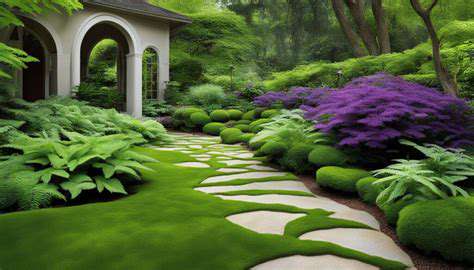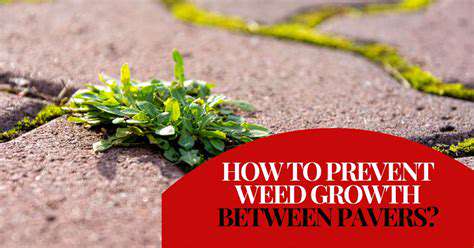Best Soils for Different Types of Plants
Understanding Clay Soil Properties
Clay soils are known for their dense, sticky texture when wet and their tendency to become hard and compacted when dry. This is due to the very small particles of clay minerals that tightly bind together, creating a high water-holding capacity. While this can be beneficial for retaining moisture, it can also lead to poor drainage and aeration, which are crucial for healthy plant growth. Understanding these inherent properties of clay soil is the first step towards successful gardening in such a soil type.
The tightly packed nature of clay particles creates a dense environment that restricts root penetration and oxygen flow. This can hinder nutrient uptake and overall plant health, potentially leading to stunted growth and increased susceptibility to diseases. Recognizing these limitations is key to developing an effective strategy for successful gardening.
Drainage and Aeration Issues
One of the significant challenges associated with clay soil is poor drainage. Excess water can lead to waterlogging, depriving roots of essential oxygen. This suffocating environment can quickly damage or kill plants. Addressing this issue often involves improving drainage by incorporating organic matter, creating raised beds, and using appropriate mulching techniques. These methods work to improve the soil structure and allow for better water flow.
Poor aeration, a consequence of poor drainage, also affects root health. Healthy roots need oxygen for respiration, just like any other living organism. By improving drainage, you indirectly enhance aeration, providing vital oxygen for root development and overall plant health. This improvement in aeration directly translates to better nutrient uptake and a stronger, healthier plant.
Improving Soil Structure with Organic Matter
Adding organic matter, such as compost, well-rotted manure, or leaf mold, is a crucial strategy for improving clay soil structure. Organic matter acts as a soil conditioner, creating spaces between clay particles that enhance drainage and aeration. This, in turn, allows for better water penetration and root growth. Incorporating organic matter is a long-term investment that gradually improves the overall health and fertility of the soil.
The addition of organic matter also improves the soil's ability to retain water and nutrients. This ensures that plants receive the necessary moisture and nourishment without being subjected to the extremes of either drought or waterlogging. By improving the soil structure, you create a more hospitable environment for plant roots and overall growth.
Choosing Appropriate Plant Species
Selecting plant species that are well-suited to clay soil is essential for successful gardening. Certain plants are more tolerant of the challenges presented by clay soil, such as poor drainage and aeration. Researching plant varieties known for thriving in clay soil can save you time and effort in the long run. Identifying these appropriate plant species is a crucial step in achieving your gardening goals.
Some plants are particularly well-adapted to the unique characteristics of clay soils. Choosing these types will reduce the need for extensive soil amendments and allow for more natural growth. By doing your research on suitable plant choices, you can significantly improve your success rate in a clay soil garden.
Utilizing Mulch for Moisture Retention and Weed Suppression
Mulching is a valuable technique for managing clay soil. A layer of mulch helps to regulate moisture levels, preventing both excessive drying and waterlogging. This consistent moisture balance is crucial for healthy plant growth. Mulch also suppresses weeds, reducing competition for nutrients and water.
Applying a consistent layer of mulch also helps to insulate the soil, maintaining a more stable temperature that is conducive to healthy root development. By effectively managing moisture and suppressing weeds, mulch significantly contributes to the overall success of gardening in clay soil, making it a highly practical and effective technique.
Loamy Soil: The Goldilocks of Gardening Mediums
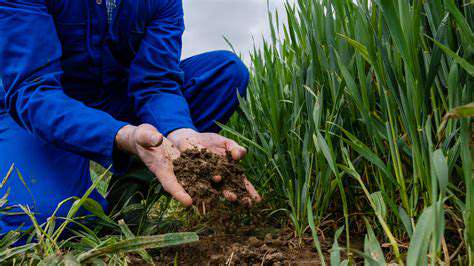
Loamy Soil Composition
Loamy soil, often hailed as the ideal growing medium, boasts a unique blend of sand, silt, and clay particles. This harmonious mix provides exceptional drainage and water retention, crucial for healthy plant growth. The proper balance of these components allows for sufficient aeration, preventing waterlogging, and ensures adequate moisture, preventing dryness. This balance is what makes loamy soil so desirable for gardeners.
The interplay of these particles creates a structure that's both porous and stable. This structure allows for easy root penetration and oxygen access, vital for robust root development. This, in turn, supports the overall health and vitality of the plants growing in the soil.
Water Retention and Drainage
Loamy soil excels in its ability to retain water effectively while also ensuring excellent drainage. This balanced approach prevents both waterlogging, which can suffocate roots, and drought conditions, which can hinder growth. This characteristic makes it particularly suitable for a wide range of plants, reducing the need for frequent watering adjustments.
The porous nature of loamy soil allows excess water to drain freely, preventing waterlogged roots and the associated issues like root rot. This feature contrasts sharply with heavy clay soils, which tend to retain water excessively, and sandy soils, which drain too quickly. This balance is a significant advantage for gardeners.
Nutrient Availability and Soil Structure
Loamy soil is a nutrient-rich environment that supports a thriving microbial community. These microorganisms play a vital role in breaking down organic matter, releasing essential nutrients for plant uptake. This continuous cycle of nutrient availability ensures consistent nourishment for plants.
The structure of loamy soil allows for excellent aeration and water infiltration. These factors are fundamental for the growth and development of healthy plant roots, leading to increased yields and more robust plants. This desirable structure is often difficult to replicate in other soil types.
Ideal for a Wide Range of Plants
The versatility of loamy soil makes it suitable for a diverse range of plants. Its balanced characteristics cater to the specific needs of various species, reducing the need for extensive soil amendments. This makes it a truly excellent choice for novice and experienced gardeners alike.
From vegetables to flowers, from herbs to shrubs, loamy soil provides a consistent and supportive environment for a wide spectrum of plant life. The adaptability and ease of use make it a popular choice for gardeners aiming to cultivate a thriving garden.
Peat Moss: A Versatile Soil Amendment for Various Plant Needs
Understanding Peat Moss
Peat moss, a naturally occurring material formed from partially decayed plant matter, is a popular soil amendment prized for its exceptional water-holding capacity and aeration properties. Its spongy texture allows for excellent drainage and water retention, creating a favorable environment for plant roots to thrive. This unique combination of characteristics makes it a valuable addition to a variety of gardening projects, from enhancing container mixes to improving the structure of garden beds.
Derived from bogs and mires, peat moss is a renewable resource, though careful harvesting practices are crucial to ensure its sustainability. It's important to choose suppliers who adhere to responsible harvesting methods to support the preservation of these delicate ecosystems.
Benefits for Plant Growth
Peat moss significantly contributes to healthy plant growth by providing a balanced environment. Its excellent water retention helps prevent overwatering and drought stress, crucial for maintaining consistent moisture levels around plant roots. This consistent moisture promotes optimal root development and overall plant health, contributing to strong, vibrant growth.
The aeration properties of peat moss also facilitate oxygen circulation around roots, preventing root rot and promoting healthy root systems. This crucial aspect contributes to overall plant vigor and resilience.
Improving Soil Structure and Drainage
One of the key benefits of using peat moss is its ability to dramatically improve soil structure. Often, garden soil lacks the necessary structure for optimal water drainage and aeration. Peat moss acts as a natural soil conditioner, improving drainage and aeration while enhancing the overall texture of the soil. This improved soil structure is essential for healthy plant growth, allowing roots to easily access water and oxygen.
Water Retention and Moisture Management
Peat moss's remarkable ability to retain water is a significant advantage in various gardening situations. Whether you're dealing with drought-prone areas or heavy clay soils that retain too much water, peat moss can help regulate moisture levels. By incorporating peat moss into the soil, you can create a more balanced and stable environment for plant roots, fostering healthier growth and reducing the risk of water-related problems.
Choosing the Right Peat Moss for Your Needs
Different types of peat moss cater to different plant requirements. Some blends are specifically formulated for container gardening, while others are better suited for amending garden beds. Consider the specific needs of your plants when selecting the appropriate peat moss type, ensuring optimal growth conditions.
Understanding the different grades of peat moss available, such as fine, medium, or coarse, can influence how it impacts the soil. Fine peat moss can create a very dense soil, while coarse peat moss will allow for more drainage.
Potential Environmental Concerns and Alternatives
While peat moss is a valuable soil amendment, concerns regarding its environmental impact exist. Sustainable harvesting practices are essential to ensure the long-term availability of peat moss and the preservation of the ecosystems from which it originates. Alternatives like coconut coir and composted bark are gaining popularity as sustainable substitutes for peat moss, offering similar benefits while minimizing environmental impact.
Integrating Peat Moss into Your Gardening Routine
Incorporating peat moss into your gardening routine is a straightforward process. Mix it thoroughly with your existing soil to improve its structure and water retention. Consider the specific needs of your plants and adjust the amount of peat moss accordingly. A good rule of thumb is to start with a small amount and gradually increase it as needed.
When using peat moss in container gardening, ensure proper drainage holes in the containers to prevent waterlogging. Follow manufacturer recommendations for optimal results.
Choosing the Right Soil for Specific Plant Types
Understanding Plant Needs
Different plants have unique soil requirements, stemming from their natural habitats and evolutionary adaptations. Knowing these needs is crucial for successful gardening. Some plants thrive in well-drained sandy soils, while others prefer the moisture retention of clay. Understanding these differences is the first step in selecting the appropriate soil for your chosen plants.
Factors like the plant's preferred pH level, water retention capacity, and aeration requirements must all be considered. Researching the specific needs of each plant species is essential for optimal growth and health.
Importance of Drainage
Adequate drainage is paramount for preventing root rot and other fungal diseases. Poor drainage can lead to waterlogging, depriving roots of oxygen and creating a breeding ground for harmful pathogens. The choice of soil significantly impacts drainage, influencing the rate at which water percolates through the soil.
Clay soils, for instance, tend to hold water, while sandy soils drain quickly. Understanding this difference is key to selecting the right soil for your plants, ensuring they receive the appropriate amount of moisture without waterlogging.
Assessing Soil Texture
Soil texture is a critical factor in plant growth. Different textures affect water retention, aeration, and nutrient availability. Sandy soils, composed primarily of sand particles, offer excellent drainage but poor water retention, while clay soils, made up of fine particles, retain water well but drain poorly. Loamy soils, which combine sand, silt, and clay, offer a balance of both properties, making them ideal for a wide range of plants.
Soil pH and Nutrient Content
The pH level of the soil significantly influences the availability of nutrients to plants. Different plants have different pH preferences. For example, blueberries thrive in acidic soil, while roses prefer slightly alkaline conditions. Testing your soil's pH is essential to ensure it's suitable for the plants you intend to grow.
Furthermore, the soil's nutrient content plays a vital role in plant health. A nutrient-poor soil may require amendments to provide essential elements for optimal growth. Understanding the specific nutrient needs of each plant type is crucial for selecting the right soil and ensuring healthy development.
Choosing Soil Based on Plant Type
Certain plant types have specific soil requirements. Trees, for instance, often require deep, well-drained soil that can support their extensive root systems. Vegetables, on the other hand, may benefit from nutrient-rich soil to support their fruit and leaf production.
Understanding these differences allows for careful selection of soil types tailored to each plant's particular needs. This ensures that the plants receive the optimal conditions for growth and development, ultimately maximizing their potential.
Amendments and Soil Improvement
Even with careful selection, you may need to amend existing soil to meet the specific needs of your plants. Adding organic matter, such as compost or peat moss, can improve drainage, water retention, and nutrient content. Adjusting the pH of the soil with appropriate amendments is also crucial for many plant types.

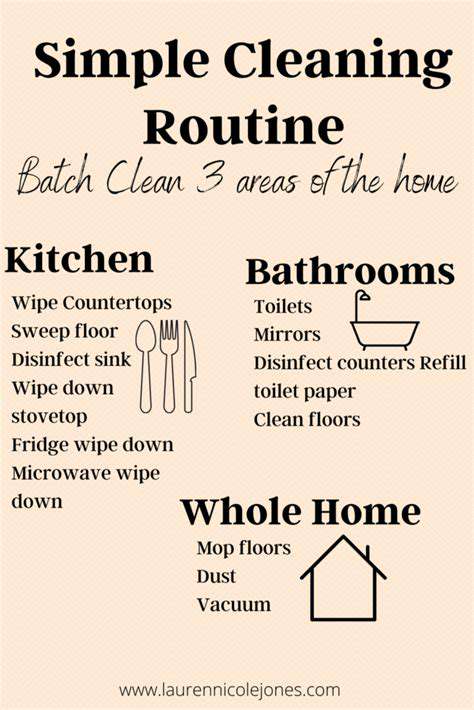

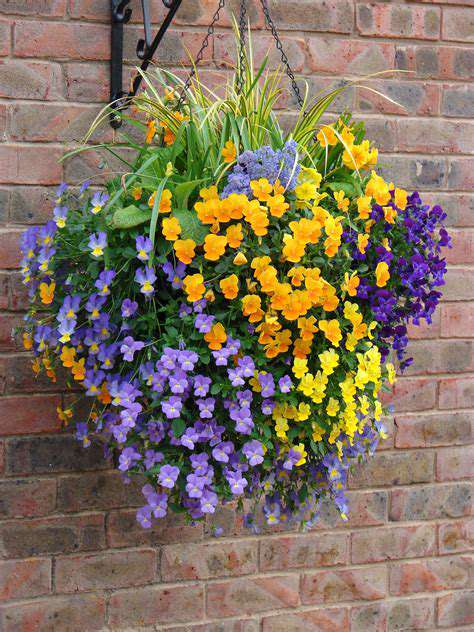
![How to Use AI Tools for Studying Effectively [Ethics]](/static/images/31/2025-05/MitigatingPotentialEthicalConcernsAssociatedwithAIStudyTools.jpg)


